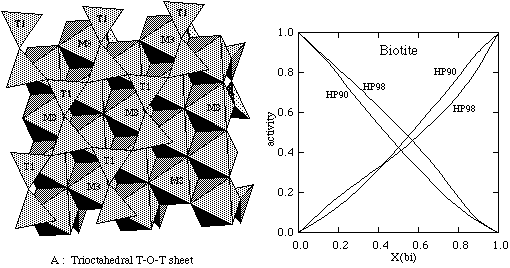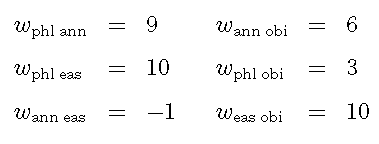
KMASH:
The ideal mixing model used in HP90 involved mixing of octahedral Al and Mg on the M2 and M3 sites in the trioctahedral mica structure, M1 being occupied only by Mg. This may be unrealistic given that Mg-Al ordering is such a strong control on the behaviour of octahedral site distributions (e.g. in omphacite and chlorite). This short range order situation is not easy to model satisfactorily, but energetically this would be much more like a hypothetical fully ordered mica in which Al and Mg can mix on only one (M3) of the three octahedral sites, such that each Al is surrounded by six Mg nearest neighbours in the octahedral sheet.

Again, the mixing of tetrahedral Al and Si is restricted to just two of the four T sites to maintain Al-avoidance, and the ideal mixing activities in the phlogopite-eastonite solid solution are given by

where XAl,M3 is the mole fraction, or proportion, of eastonite in the biotite. Non-ideal mixing is implied for this system by the calorimetric study of Circone & Navrotsky (1992) where a significant heat of mixing was demonstrated. The value and uncertainty in Wphl-east can be reduced to 10.0±4 kJ by removing the most aluminous biotite data point. This value is therefore used together with the ideal activities above in the form of a symmetric regular solution.
An example of the above, coded for THERMOCALC is as follows:
%========= Biotites in KMASH ===============
% -- phlogopite 3M-2T model ---
bi 2
y(bi) 0.01
% --------------------------------------------------
p(phl) 1 1 1 1 -1 y
p(east) 1 1 0 1 1 y
% --------------------------------------------------
sf
W(phl,east) 10 0 0
% --------------------------------------------------
4 % no of site fractions
x(Al,M1) 1 1 0 1 1 y
x(Mg,M1) 1 1 1 1 -1 y
x(Al,T1) 1 1 1/2 1 1/2 y
x(Si,T1) 1 1 1/2 1 -1/2 y
% --------------------------------------------------
phl 4 3 x(Mg,M1) 1 x(Al,T1) 1 x(Si,T1) 1
east 1 2 x(Al,M1) 1 x(Al,T1) 2
%__________________________________________________________________
Although the enthalpy of phlogopite does not depend on any activity model, the enthalpy of the eastonite end-member does depend on this mixing model. The new activities at 600°C are similar to those from HP90, but the non-ideality in the new model will make these a function of temperature and extension to Fe-bearing systems becomes a little more complex.
KFMASH:
In the larger system with Fe, the possibility of Fe and Mg ordering occurs. For convenience we shall call the Al-loving site M1 and the other two sites (which take Fe & Mg) will be called M2. It will also be assumed that Fe orders onto M1 preferentially:
|
|
|
|
|
|
|
|
|
|
|
|
|
|
|
|
|
|
|
|
|
|
|
|
|
The site distributions are given by the following, where x1 and x2 are the proportions Fe/(Fe+Mg) on the M1 and M2 sites respectively:

Which leads to the following ideal mixing on sites activities:

The site fractions in terms of proportions of end-members are XAlM1=peas, XFeM1=1-peas-pphl, XMgM1=pphl, XFeM2=pann, XAlT1=(1+peas)/2 and XSiT1=(1-peas)/2 which allow the activities to be written in terms of the proportions of an independent set (phl, ann, eas) of end-members:

The non-ideal contributions to the activity are given by a regular solution among the four end-members:

although for use in THERMOCALC, obi (= 1 - phl - eas - ann) would be eliminated so that the relations were all in terms of just the independent set of composition variables.
Calibration is discussed in Powell & Holland (1998, submitted Am Min) where the complete model for biotites becomes (in kJ/mol):

Coded for THERMOCALC the above looks like:
%========= Biotites in KFMASH ===============
bi 4
x(bi) 0.4 % bulk Fe/(Fe + Mg)
y(bi) 0.25 % x(Al,M1)
N(bi) 0.14 % 3(x - x(Fe,M2))
% --------------------------------------------------
p(phl) 2 2 1 1 -1 x 1 1 -1 y
1 0 1 -2/3 N
p(ann) 1 1 0 2 1 x -1/3 N
p(east) 1 1 0 1 1 y
p(obi) 2 2 0 1 -1 x 0 1 1 y
1 0 1 1 N
% --------------------------------------------------
sf
W(phl,ann) 9 0 0
W(phl,east) 10 0 0
W(phl,obi) 3 0 0
W(ann,east) -1 0 0
W(ann,obi) 6 0 0
W(east,obi) 10 0 0
% --------------------------------------------------
7 % no of site fractions
x(Al,M1) 1 1 0 1 1 y
x(Fe,M1) 2 2 0 1 1 x 1 1 -1 y
1 0 1 2/3 N
x(Mg,M1) 2 2 1 1 -1 x 1 1 -1 y
1 0 1 -2/3 N
x(Fe,M2) 1 1 0 2 1 x -1/3 N
x(Mg,M2) 1 1 1 2 -1 x 1/3 N
x(Al,T1) 1 1 1/2 1 1/2 y
x(Si,T1) 1 1 1/2 1 -1/2 y
% --------------------------------------------------
phl 4 4 x(Mg,M1) 1 x(Mg,M2) 2 x(Al,T1) 1 x(Si,T1) 1
check 0 0 0
ann 4 4 x(Fe,M1) 1 x(Fe,M2) 2 x(Al,T1) 1 x(Si,T1) 1
check 1 0 0
east 1 3 x(Al,M1) 1 x(Mg,M2) 2 x(Al,T1) 2
check 0 1 0
obi 4 4 x(Fe,M1) 1 x(Mg,M2) 2 x(Al,T1) 1 x(Si,T1) 1
make 2 phl 2/3 ann 1/3
DQF -10.73 0 0
check 1/3 0 1
|
|